
Understanding and Treating Skin Rashes: A Comprehensive Guide

Skin rashes are a common concern for people of all ages, often causing discomfort, worry, and confusion. This guide will help you identify different types of skin rashes, understand their causes, and learn about treatment options.
Types of Skin Rashes
- Contact Dermatitis: Caused by direct contact with an irritant or allergen. Symptoms include redness, itching, and sometimes blistering.
- Atopic Dermatitis (Eczema): A chronic condition characterized by dry, itchy skin that can become red and inflamed.
- Psoriasis: An autoimmune condition causing thick, scaly patches on the skin.
- Heat Rash: Occurs when sweat ducts become blocked, leading to small, itchy bumps.
- Hives: Raised, itchy welts that can appear suddenly due to allergic reactions or other triggers.
- Fungal Infections: Such as ringworm or athlete’s foot, causing circular, itchy rashes.
- Viral Rashes: Including those caused by chickenpox, measles, or roseola.
Identifying Rashes
To identify a rash, consider:
- Appearance (color, texture, shape)
- Location on the body
- Associated symptoms (itching, pain, fever)
- Recent exposures to potential triggers
Treatment Options
Over-the-counter treatments:
- Hydrocortisone cream for itching and inflammation
- Antihistamines for allergic reactions
- Antifungal creams for fungal infections
Home remedies:
- Cool compresses to soothe irritation
- Oatmeal baths for itching
- Aloe vera for cooling and healing
Prescription medications:
- Stronger corticosteroids for severe inflammation
- Antibiotics for bacterial infections
- Antiviral medications for certain viral rashes
Lifestyle changes:
- Avoiding known triggers
- Using gentle, fragrance-free skincare products
- Maintaining proper hygiene
When to See a Doctor
Consult a healthcare professional if:
- The rash is widespread or severe
- You have fever or other systemic symptoms
- The rash doesn’t improve with home treatment
- You suspect an allergic reaction
Conclusion
Understanding and managing skin rashes is an important aspect of overall health and well-being. While many common rashes can be effectively treated at home with over-the-counter remedies and lifestyle adjustments, it’s crucial to recognize when professional medical attention is necessary.
Remember that each person’s skin is unique, and what works for one individual may not be as effective for another. Patience and consistency are key when treating skin conditions, as many rashes take time to heal completely.
By staying informed about different types of rashes, their causes, and treatment options, you can better care for your skin and that of your loved ones. Always err on the side of caution – if you’re unsure about a rash or if symptoms persist despite home treatment, don’t hesitate to consult with a dermatologist or healthcare provider.
Ultimately, maintaining healthy skin involves a combination of preventive measures, prompt attention to skin changes, and appropriate treatment. With the right knowledge and care, you can effectively manage most skin rashes and maintain healthy, comfortable skin.
Stay vigilant, listen to your body, and prioritize your skin health. After all, your skin is your body’s largest organ and deserves the best care possible.
Frequently Asked Questions

Dr. Akansh Jain
MBBS, MD (Dermatology/DVL)
Consultant Dermatologist & Cosmetologist






